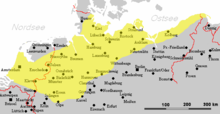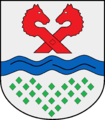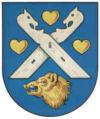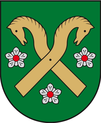Horse heads (gable decoration)
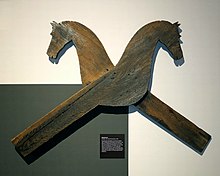
The horse's heads (rarely also heads of other animal species), also known as stallion and hors or Rossgoschen , are an ornament of the windboards on the gable of the roof that is often found in Low German hall houses . The boards are pulled out about half a meter above the roof ridge and cross each other in the form of a slope .
Practical function
Traditionally, there was often an opening at the top of the gable, the owl hole . Through this opening the smoke from the stove could escape and owls could enter the attic to catch mice. The roof was traditional, rare thatched with reed covered. In order to protect the edges ( ridge , ridge ) of the thatched or thatched roof from fraying by gusts of wind, these were often framed with wind boards (also: wind springs ). At the owl hole, these windboards were often pulled over the top to add decorations. It is unclear whether the wind boards also served to reduce wind noise.
layout
In their simplest form, two simple, stylized horse heads were sawn or carved out of the windboards, either facing or facing away from each other.
Depending on the skill and ambition of the carpenter, the heads were sculpted, the manes and bridles of the horses were appropriately finely worked out and the horses were decorated with other symbols (birds, trees, flowers, oak leaves, stars, sun wheels, hearts ...). Sometimes the gable boards were so ornate that they could hardly be recognized as horses.
History and symbolism


The symbolism behind the horse's heads has not been passed down clearly. Popular belief has various interpretations, but these cannot be conclusively proven historically. It is also unclear how far the tradition of this gable decoration goes back. There are indications that the heads are significantly younger than the common interpretation as a pagan-Germanic symbol would lead you to believe. In the Heimat movement - especially under National Socialism - this origin was glorified and glorified. In fact, due to the material and the effects of the weather at an exposed location, there is no clear evidence of its spread as gable decoration that is significantly older than 400 years. An impressive example of the spread in northern Germany in the 16th century is the role of Vicke Schorler , which shows numerous gables decorated in this way on the houses in the neighboring villages of Rostock . Much older sources with representations of house signs are mentioned by Richard Wolfram . In particular, he goes into the Bayeux Tapestry from the 11th century, on which numerous different house signs are shown in the roof area. The oldest cited find describes gable boards with a horse-head-like design in the Latène period (5th – 1st century BC) settlement Wallburg Altenburg in the Hunsrück .
Sources report that in northern Germany it was said to have been the custom in the 16th century to put real horse heads on poles next to a house to avert danger. Some folklorists argue that originally images of all kinds of animal and human grimaces ( see also: Neidkopf ) were attached to houses to prevent danger. In some northern German areas the custom was then increasingly restricted to horse heads. So these horses heads today as hot gable decorations in Mecklenburg still Muulapen ( mouth monkey ).
In Lower Saxony the horse was and is by far the most frequently used animal symbol. This is mainly due to the fact that the Sachsenross is the heraldic animal of the Guelph dukes. Older research assumed it was used as a heraldic animal in pre-Christian times. Today, however, this interpretation is out of date, as the use of the horse as an army symbol or the like in the Old Saxons cannot be proven.
The symbolism behind the horse's line of sight (inward or outward) and the number of reins is also unclear. Various interpretations are widespread in popular belief, but none of them can be historically or statistically proven.
distribution

The largest distribution area is northern Germany and begins in the west in the Lower Saxony areas of influence of the Netherlands and Westphalia . From there it extends over Friesland , the Old Country and Lüneburg in Lower Saxony via Holstein , Mecklenburg and Pomerania to East Prussia . The distribution area is interrupted, especially in the west, by sprinkles with gable posts (Westphalia, Hanover ), swan gables (Friesland) and ornamental house signs (Altes Land). These house signs can also be found in the neighboring areas in Scandinavia , the Baltic States and Poland . In Central Germany , horse head gables are or were isolated in the Westerwald , Siegener Land and Thuringia . Another large distribution area is in parts of Austria ( Lower Austria , Tyrol ) and the adjacent areas in Upper Bavaria , the Czech Republic ( South Bohemia ), Switzerland ( Engadin ), but also in areas that are still or once German-populated in northern Italy and south-eastern Europe . Similar constructions are also widespread in northern Russia. In England and the Romance countries, however, these house signs do not occur.
Use as a coat of arms symbol
Especially in more recent times (from the beginning of the 20th century) crossed horse heads have found their way into heraldry as part of the homeland movement . Many communities used the crossed gable boards in the coat of arms as a symbol of a supposedly Germanic or Old Saxon tradition.
As a common figure , two boards are crossed, the ends of which point towards the head of the shield, mostly ending in stylized horse heads . These can be facing outwards , averted or facing , that is, they look to the right and left or look at each other. Other ends of the crossed boards are also possible. All heraldic colors can be used.
Cooperatives
The horses' heads are also the hallmark of the Raiffeisen - cooperatives . The Raiffeisen cooperatives, particularly the Raiffeisen banks in Germany, Austria and South Tyrol, use a stylized gable cross made of crossed horse heads as their brand symbol. In Germany there has been a joint logo for Volksbanken and Raiffeisenbanken since 2002, which is composed of half a Volksbank logo and half a gable cross .
After an entry on the website of Raiffeisenzentralbank Austria, this trademark was introduced because it symbolizes protection and security for the members. The gable cross had been in use in Germany as a uniform trademark of Raiffeisen since 1935. According to a report by the Upper Austrian Raiffeisenlandesbank, the Austrian Raiffeisen cooperatives introduced it between 1942 and 1944.
Examples as a heraldic figure
Ilgakiemis ( Lithuania )
Examples as a symbol
Logo of the German Raiffeisen Association
Other gable figures
Crossed swan necks are known from the Old Country , and crossed snakes from the Spreewald . The coat of arms of the Danish administrative district Vestsjællands Amt contains two basilisk heads in this arrangement. In general, gable board ends have been decorated with gable, ridge or finial since the Gothic period.
See also
- Roof decorations
- Sachsenross
- Decorations on the Low German hall house
- Weathercock
- Windboard
- Limp Claw
Web links
Individual evidence
- ↑ The world of gable signs. Freddie Bijkerk, Stralsund August 2006 ( Memento of the original dated December 6, 2015 in the Internet Archive ) Info: The archive link was inserted automatically and has not yet been checked. Please check the original and archive link according to the instructions and then remove this notice. (PDF; 332 kB)
- ^ The large art lexicon by PW Hartmann - Horse heads, crossed
- ↑ a b Forest Adventure Center Ehrhorn-No1 - horse heads as gable decoration
- ↑ a b Attempts to interpret horses' heads. ( Page no longer available , search in web archives ) Info: The link was automatically marked as defective. Please check the link according to the instructions and then remove this notice. Historikhaus.de
- ↑ a b Richard Wolfram: The crossed horse heads as a gable sign . Verlag A.Schendl, Vienna 1968
- ↑ Chr. Petersen: The horse heads on the farmhouses, especially in northern Germany . In: Yearbooks for regional studies of the duchies of Schleswig, Holstein and Lauenburg , Volume 3. Kiel 1860, p. 220 f., Digitized full text , job details ; "Muulapen" = Low German: "gape"
- ↑ Fachwerk.de - Horse heads on half-timbered house gables
- ↑ Hans Menzel: Bridal door and coat of arms, Kerbholz and crossed horse heads. Publications of the Molfsee Open Air Museum 2014, ISBN 978-3-9813217-4-6 , pp. 25–50.
- ↑ Культ коня в деревянном зодчестве Руси и Германии
- ↑ Explanation of the trademark ( memento of the original from September 29, 2007 in the Internet Archive ) Info: The archive link was inserted automatically and has not yet been checked. Please check the original and archive link according to the instructions and then remove this notice.
- ↑ Gable cross as a Raiffeisen symbol ( memento of the original from October 16, 2011 in the Internet Archive ) Info: The archive link was inserted automatically and has not yet been checked. Please check the original and archive link according to the instructions and then remove this notice.
- ^ Hermann Allmers: Marschenbuch: Land and Volksbilder from the marshes of the Weser and Elbe . Hugo Scheube publishing house, Gotha 1858
- ↑ lr-online.de
- ↑ Klaus Gauger: Arnshaugk - a reading book . Verlag Edition Arnshaugk, 2009, ISBN 978-3-926370-36-5

